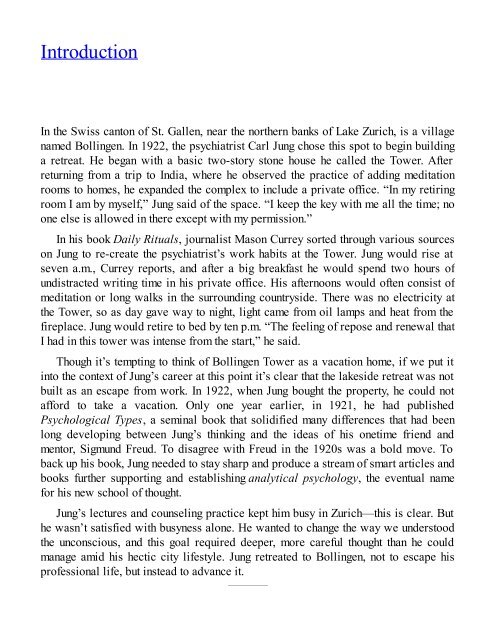Deep Work_ Rules for focused success in a distracted world ( PDFDrive.com )
Create successful ePaper yourself
Turn your PDF publications into a flip-book with our unique Google optimized e-Paper software.
Introduction<br />
In the Swiss canton of St. Gallen, near the northern banks of Lake Zurich, is a village<br />
named Boll<strong>in</strong>gen. In 1922, the psychiatrist Carl Jung chose this spot to beg<strong>in</strong> build<strong>in</strong>g<br />
a retreat. He began with a basic two-story stone house he called the Tower. After<br />
return<strong>in</strong>g from a trip to India, where he observed the practice of add<strong>in</strong>g meditation<br />
rooms to homes, he expanded the <strong>com</strong>plex to <strong>in</strong>clude a private office. “In my retir<strong>in</strong>g<br />
room I am by myself,” Jung said of the space. “I keep the key with me all the time; no<br />
one else is allowed <strong>in</strong> there except with my permission.”<br />
In his book Daily Rituals, journalist Mason Currey sorted through various sources<br />
on Jung to re-create the psychiatrist’s work habits at the Tower. Jung would rise at<br />
seven a.m., Currey reports, and after a big breakfast he would spend two hours of<br />
un<strong>distracted</strong> writ<strong>in</strong>g time <strong>in</strong> his private office. His afternoons would often consist of<br />
meditation or long walks <strong>in</strong> the surround<strong>in</strong>g countryside. There was no electricity at<br />
the Tower, so as day gave way to night, light came from oil lamps and heat from the<br />
fireplace. Jung would retire to bed by ten p.m. “The feel<strong>in</strong>g of repose and renewal that<br />
I had <strong>in</strong> this tower was <strong>in</strong>tense from the start,” he said.<br />
Though it’s tempt<strong>in</strong>g to th<strong>in</strong>k of Boll<strong>in</strong>gen Tower as a vacation home, if we put it<br />
<strong>in</strong>to the context of Jung’s career at this po<strong>in</strong>t it’s clear that the lakeside retreat was not<br />
built as an escape from work. In 1922, when Jung bought the property, he could not<br />
af<strong>for</strong>d to take a vacation. Only one year earlier, <strong>in</strong> 1921, he had published<br />
Psychological Types, a sem<strong>in</strong>al book that solidified many differences that had been<br />
long develop<strong>in</strong>g between Jung’s th<strong>in</strong>k<strong>in</strong>g and the ideas of his onetime friend and<br />
mentor, Sigmund Freud. To disagree with Freud <strong>in</strong> the 1920s was a bold move. To<br />
back up his book, Jung needed to stay sharp and produce a stream of smart articles and<br />
books further support<strong>in</strong>g and establish<strong>in</strong>g analytical psychology, the eventual name<br />
<strong>for</strong> his new school of thought.<br />
Jung’s lectures and counsel<strong>in</strong>g practice kept him busy <strong>in</strong> Zurich—this is clear. But<br />
he wasn’t satisfied with busyness alone. He wanted to change the way we understood<br />
the unconscious, and this goal required deeper, more careful thought than he could<br />
manage amid his hectic city lifestyle. Jung retreated to Boll<strong>in</strong>gen, not to escape his<br />
professional life, but <strong>in</strong>stead to advance it.



